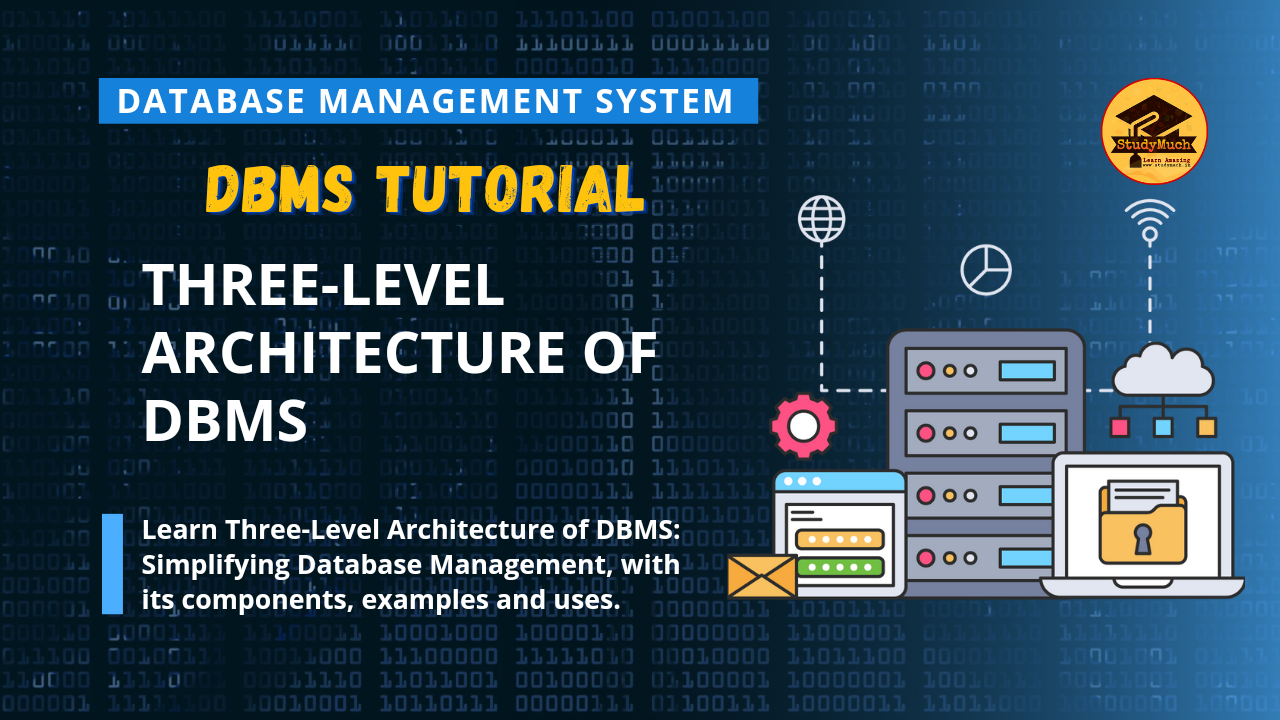Three-Level Architecture of DBMS

The Three-Level Architecture of DBMS: Simplifying Database Management
Database management systems (DBMS) are essential tools used to store, manage, and retrieve large amounts of data efficiently. The Three-Level Architecture, also known as the Three-Tier Architecture, is a widely used approach in DBMS that provides a systematic way to organize and manage data in a complex database system. In this blog post, we will learn the Three-Level Architecture of DBMS, with its components, examples and uses.
Definition of Three-Level Architecture of DBMS
The Three-Level Architecture of DBMS is a conceptual model that divides a database management system into three distinct layers, each with its specific function. These three layers are given below with definition.

1. External Level (User View): This is the topmost layer of the Three-Level Architecture, also known as the User View or External Schema. It represents the way in which users interact with the database system. It defines the user’s perspective of the data and how they view and manipulate it. This layer is designed to provide a customized view of the data to different users or groups of users based on their requirements. For example, in a university database, the external schema for the faculty may include information about courses they teach, while the external schema for students may include information about courses they are enrolled in.
2. Conceptual Level (Logical View): This is the middle layer of the Three-Level Architecture, also known as the Logical View or Conceptual Schema. It defines the logical structure of the entire database system and provides a global view of the data. It represents the relationships among the different data elements and the overall structure of the database. The conceptual schema acts as an intermediary between the external schema and the physical schema, translating the user’s view of the data into a form that can be stored in the database. For example, in a sales database, the conceptual schema may define entities such as customers, products, and orders, and their relationships.
3. Internal Level (Physical View): This is the bottommost layer of the Three-Level Architecture, also known as the Physical View or Internal Schema. It deals with the actual storage and retrieval of data in the database system. It defines how the data is stored on the storage devices, such as disks, and how it is accessed and retrieved. It includes details such as file organization, data indexing, and data compression techniques. The internal schema is optimized for efficient storage and retrieval of data and is transparent to the users and the external schema. For example, in a payroll database, the internal schema may define the physical structure of employee records, including fields such as name, address, and salary, and how they are stored in the database.
Example of Three-Level Architecture of DBMS
Let’s take an example of a customer relationship management (CRM) system to illustrate the Three-Level Architecture of DBMS.
External Level (User View): The CRM system may have multiple user views, such as views for sales representatives, managers, and customer support staff. The sales representatives’ view may include information about customers, contacts, and leads, while the managers’ view may include additional information about sales performance, targets, and forecasts.
Conceptual Level (Logical View): The conceptual schema of the CRM system may define entities such as customers, contacts, leads, opportunities, and sales. It may also define the relationships among these entities, such as a customer having multiple contacts, a lead converting into an opportunity, and an opportunity resulting in a sale. The conceptual schema provides a unified and consistent view of the data across different user views.
Internal Level (Physical View): The internal schema of the CRM system may define how the data is stored on the physical storage devices, such as disks. It may include details such as file organization, data indexing, and data compression techniques to optimize the storage and retrieval efficiency. For example, it may define the use of B-trees for indexing customer records, and a combination of row-based and columnar storage for different types of data.
Uses of Three-Level Architecture of DBMS
The Three-Level Architecture of DBMS offers several benefits in the management of complex databases:
Data Independence: One of the key advantages of the Three-Level Architecture is data independence. The separation of the external, conceptual, and internal levels allows for changes to be made at one level without affecting the other levels. For example, if there is a need to add a new field to a customer record, it can be done at the external schema level without affecting the conceptual or internal schema. This provides flexibility and scalability in managing databases, as changes can be made at the appropriate level without disrupting the entire system.
Customized User Views: The external schema or user view allows for customization of data presentation for different users or groups of users. Different users may have different requirements and perspectives on the data, and the external schema enables the creation of tailored views to meet their specific needs. This ensures that users have access to relevant information and can work with the data in a way that is meaningful to them.
Logical Data Organization: The conceptual schema or logical view provides a logical organization of data that is independent of any specific physical storage details. This allows for a clear and unified view of the database system, with relationships among entities and data elements defined at a high level. It simplifies the understanding and management of complex databases, as changes in the physical storage or implementation details do not impact the logical structure of the data.
Efficient Physical Storage: The internal schema or physical view is optimized for efficient storage and retrieval of data. It includes considerations such as file organization, indexing, and compression techniques that can enhance the performance of the database system. By separating the physical storage details from the logical and user views, the Three-Level Architecture allows for optimizations at the physical level without affecting the logical or user perspectives.
Conclusion
The Three-Level Architecture of DBMS is a widely used approach in organizing and managing complex databases. It provides a clear separation of the user view, logical view, and physical view, offering data independence, customized user views, logical data organization, and efficient physical storage. It simplifies the management of large databases, allows for flexibility and scalability, and enhances performance. Understanding the Three-Level Architecture is crucial for database administrators, developers, and users to effectively manage and utilize databases in various applications such as CRM, ERP, e-commerce, and more.
So, in this blog post you have learned the Three-Level Architecture of DBMS (Database Management System) with its components, examples and uses. I hope you have leaned better and if you have any doubt regarding this tutorial then you can ask in the comment section.
Learn Related;



16 Comments
content · December 27, 2023 at 11:36 am
It is in reality a nice and useful piece of info. I am satisfied that you just shared this useful information with us. Please keep us informed like this. Thanks for sharing.
bokep indo · March 17, 2024 at 12:56 pm
Heya i am for the first time here. I found this board and I find It really useful & it helped me out a lot. I hope to give something back and help others like you helped me.
kontol kuda · April 9, 2024 at 1:19 pm
Wow that was strange. I just wrote an really long comment but after I clicked submit my comment didn’t show up. Grrrr… well I’m not writing all that over again. Anyway, just wanted to say fantastic blog!
video porno · May 6, 2024 at 3:30 pm
Thank you, I have recently been looking for info about this subject matter for ages and yours is the best I’ve found so far.
kontol kuda · May 7, 2024 at 3:24 am
Hello there! This post could not be written any better! Reading through this post reminds me of my good old room mate! He always kept chatting about this. I will forward this post to him. Fairly certain he will have a good read. Many thanks for sharing!
Thca Flower · June 30, 2024 at 10:46 pm
Your house is valueble for me. Thanks!?
rich queen login · July 15, 2024 at 2:19 am
Useful information. Fortunate me I found your web site by chance, and I am surprised why this twist of fate didn’t came about in advance! I bookmarked it.
house cleaning · July 29, 2024 at 2:55 am
Superb post however , I was wanting to know if you could write a litte more on this subject? I’d be very grateful if you could elaborate a little bit more. Kudos!
ตํานานหมิงหลัน pantip · August 1, 2024 at 5:49 pm
Heya i am for the first time here. I found this board and I in finding It really helpful & it helped me out a lot. I hope to present something again and help others like you helped me.
Data Center Optimization · September 11, 2024 at 12:27 pm
Heya i am for the first time here. I found this board and I find It really useful & it helped me out much. I hope to give something back and aid others like you helped me.
situs bo slot gacor · September 13, 2024 at 7:47 pm
This is really interesting, You’re a very skilled blogger. I have joined your feed and look forward to seeking more of your great post. Also, I have shared your site in my social networks!
ซีรี่ย์จีน123 · September 20, 2024 at 12:08 pm
My brother recommended I might like this blog. He was totally right. This post actually made my day. You can not imagine just how much time I had spent for this information! Thanks!
เครดิตฟรีถอนได้100 · September 26, 2024 at 4:44 am
F*ckin? tremendous things here. I?m very glad to see your article. Thanks a lot and i’m looking forward to contact you. Will you please drop me a e-mail?
succubus kita · September 28, 2024 at 5:28 am
This really answered my problem, thanks!
zentai · September 28, 2024 at 3:13 pm
you’re really a good webmaster. The website loading speed is incredible. It seems that you’re doing any unique trick. Also, The contents are masterwork. you have done a wonderful job on this topic!
the queens banquet งานเลี้ยงของราชินี · September 29, 2024 at 4:30 pm
very nice post, i actually love this website, keep on it